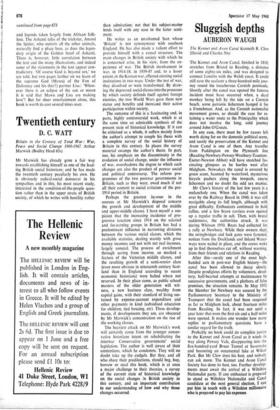Sluggish depths
AUBERON WAUGH
The Kennet and Avon Canal Kenneth R. Clew (David and Charles 50s) The Kennet and Avon Canal, finished in 1810, stretches from Bristol to Reading, a distance of some eighty-six miles, and was designed to connect London with the Welsh coast. It could still save the seafarer a three-hundred-mile jour- ney round the treacherous Cornish peninsula. Shortly after the canal- was opened the famous incident must have occurred when, a dead monkey being left by the tide on a Cornish beach, some patriotic fishermen hanged it for a Frenchman. And, as the Cornish nationalist movement grows, so should the case for re- taining a water route to the Principality which does not involve the long, cold journey around John O'Groats.
In any case, there must be few causes left, worth dying for on the domestic political scene, and surely the preservation of the Kennet and Avon Canal is one of them. Any traveller from Paddington on the Plymouth line (Reading-Newbury-Pewsey-Westbury-Taunton- Exeter-Newton Abbot) will have snatched fas- cinating glimpses as he hurtles west after Midgham. Nowadays the canal is covered by green scum, haunted by waterfowl, mysterious bicycle pushers along the towpath, coarse fishermen and no doubt the odd sex maniac.
Mr Clew's history of the last few years is a melancholy one. When the canal was taken over by the Railway Board in 1940, it was still navigable along its full length, although with great difficulty. Enthusiasts continued to .hold rallies, and a few brave carriers even opened up a regular traffic in salt. Then, with brutal, suddenness, the authorities struck. It was during Whitsun 1950. Boats had collected for . a rally at Newbury. While their owners slept, the swingbridges and lock gates were fastened, notices from the Docklands and Inland Water- ways were nailed in place, and the crews woke up to find themselves cut off, without warning,, from their friends and relations in Reading. . After this—surely one of the most high- handed acts in post-war English history—the canal has been allowed to decay slowly.
Despite prodigious efforts by volunteers; desul- tory, half-hearted attempts at maintenance by successive governments, and a plethora of false promises, the situation remains. In May 1952 the Member for Newbury was assured by the Parliamentary Secretary to the Ministry of Transport that the canal had been reopened as far as Midgham lock, about fourteen miles from Reading. In fact, it was not until a year later that even the first six and a half miles were opened. It makes one wonder how many replies to parliamentary questions have a similar regard for the truth.
Probably no book could do complete justice to the Kennet and Avon Canal as it winds its way along Pewsey Vale, disappearing into the five-hundred-yard Bruce Tunnel at Savernake and becoming an ornamental lake at Wilcot Park. But Mr Clew does his best, and nobody can ask more. The Kennet and Avon Canal Society has done its best, too. Further develop- ments must await the arrival of a Wiltshire Nationalist party. If any enthusiast is prepared to stand as Wiltshire Nationalist and Canal candidate at the next general election, I can put him in touch with a Wiltshire millionaire who is prepared to pay his expenses.






































 Previous page
Previous page